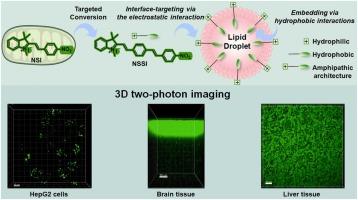通过仅插入一个苯乙烯基团,将线粒体定向转化为亚硝基苯乙烯酰胺的脂滴
IF 3.7
1区 化学
Q1 CHEMISTRY, ANALYTICAL
引用次数: 0
摘要
脂滴作为一种高度动态的细胞器,负责中性脂质的储存,在维持脂质和能量代谢中起着至关重要的作用。因此,开发荧光探针来成像ld的动态(产生、融合、生长和降解)可以为许多病理生理过程提供有价值的见解。本研究强调了一种靶向转化策略,通过简单地将一个苯乙烯基团插入到亚硝基苯基lindolium (IR-418)中,快速制备一种名为NSSI的新型LD荧光探针,这是一种众所周知的线粒体靶向探针。与亲本IR-418 (ClogP = 4.10)相比,苯乙烯基的插入使自伤分子的亲脂性(ClogP = 6.37)提高,从而有利于其通过疏水相互作用嵌入到ld的无水核心中,同时通过其吲哚部分与ld带负电的极壳之间的静电相互作用实现界面靶向,从而实现对ld的特异性靶向。通过使用自伤,我们成功地监测了不同细胞模型中ld的形态和动态变化。我们还观察了光血栓性中风小鼠模型脑组织梗死区和正常区LD分布的差异,观察了急性肝衰竭(ALF)小鼠模型肝组织中肝索破坏和严重脂肪变性的情况,并观察了斑马鱼胚胎中富含脂质的区域。总的来说,这些发现表明,无论是在细胞模型、组织样本还是体内情况下,自伤作为动态LD成像的高度通用工具的潜力。本文章由计算机程序翻译,如有差异,请以英文原文为准。

Targeted conversion from mitochondria to lipid droplets of nitrostyrylindolium by inserting only a styryl group
As highly dynamic cellular organelles responsible for the storage of neutral lipids, lipid droplets (LDs) assume crucial roles in maintaining lipid and energy metabolism. Hence, developing fluorescent probes for imaging the dynamics of LDs (generation, fusion, growth, and degradation) can offer valuable insights into numerous pathophysiological processes. This study highlights a targeted conversion strategy for promptly fabricating a novel LD fluorescent probe named NSSI by simply inserting a styryl group into nitrostyrylindolium (IR-418), a well-known mitochondria-targeted probe. The insertion of a styryl group enables an increase in the lipophilicity of NSSI (ClogP = 6.37) compared with the parent IR-418 (ClogP = 4.10), thereby facilitating its embedding into the waterless core of LDs via hydrophobic interaction, along with an interface-targeting through the electrostatic interaction between its indolium moiety and the negatively charged polar shell of LDs, to achieve its specific targeting towards LDs. By utilizing NSSI, we have successfully monitored the morphology and dynamic alterations of LDs in diverse cellular models. We have also observed the LD distribution differences between the infarcted and normal regions in the brain tissues of a photothrombosis stroke mouse model, visualized disrupted hepatic cords and severe steatosis within the liver tissues of an acute liver failure (ALF) mouse model, and witnessed the lipid-rich areas in zebrafish embryos. Overall, these findings signify the potential of NSSI as a highly versatile tool for dynamic LD imaging, whether in cellular models, tissue samples, or in vivo scenarios.
求助全文
通过发布文献求助,成功后即可免费获取论文全文。
去求助
来源期刊

Sensors and Actuators B: Chemical
工程技术-电化学
CiteScore
14.60
自引率
11.90%
发文量
1776
审稿时长
3.2 months
期刊介绍:
Sensors & Actuators, B: Chemical is an international journal focused on the research and development of chemical transducers. It covers chemical sensors and biosensors, chemical actuators, and analytical microsystems. The journal is interdisciplinary, aiming to publish original works showcasing substantial advancements beyond the current state of the art in these fields, with practical applicability to solving meaningful analytical problems. Review articles are accepted by invitation from an Editor of the journal.
 求助内容:
求助内容: 应助结果提醒方式:
应助结果提醒方式:


